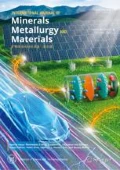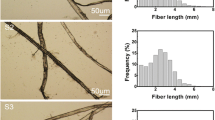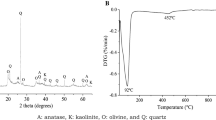Abstract
The inadvertent dissolution of gangue minerals is frequently detrimental to the flotation of valuable minerals. We investigated the effect of conditioning time on the separation of brucite and serpentine by flotation. By analyzing the Mg2+ concentration, relative element content, and pulp viscosity, we studied the effect of mineral dissolution on brucite flotation. The results of artificially mixed mineral flotation tests (with −10 µm serpentine) showed that by extending the conditioning time from 60 to 360 s, a large amount of Mg2+ on the mineral surface gradually dissolved into the pulp, resulting in a decreased brucite recovery (from 83.83% to 76.79%) and an increased recovery of serpentine from 52.12% to 64.03%. To analyze the agglomeration behavior of brucite and serpentine, we used scanning electron microscopy, which clearly showed the different adhesion behaviors of different conditioning times. Lastly, the total interaction energy, as determined based on the extended DLVO (Derjaguin-Landau-Verwey-Overbeek) theory, also supports the conclusion that the gravitational force between brucite and serpentine increases significantly with increased conditioning time.
Similar content being viewed by others
References
C. Blawert, W. Dietzel, E. Ghali, and G. Song, Anodizing treatments for magnesium alloys and their effect on corrosion resistance in various environments, Adv. Eng. Mater., 8(2006), No. 6, p. 511.
G.I. Pushkaryova, Effect of temperature treatment of brucite on its sorption properties, J. Min. Sci., 36(2000), No. 6, p. 599.
A.M. Kusuma, Q.X. Liu, and H.B. Zeng, Understanding interaction mechanisms between pentlandite and gangue minerals by zeta potential and surface force measurements, Miner. Eng., 69(2014), p. 15.
D.Z. Liu, G.F. Zhang, G.H. Huang, Y.W. Gao, and M.T. Wang, The flotation separation of pyrite from serpentine using lemon yellow as selective depressant, Colloids Surf. A, 581(2019), art. No. 123823.
K.L. Zhao, W. Yan, X.H. Wang, G.H. Gu, J. Deng, X. Zhou, and B. Hui, Dispersive effect of low molecular weight sodium polyacrylate on pyrite-serpentine flotation system, Physicochem. Probl. Miner. Process., 53(2017), No. 2, p. 1200.
C.R. Edwards, W.B. Kipkie, and G.E. Agar, The effect of slime coatings of the serpentine minerals, chrysotile and lizardite, on pentlandite flotation, Int. J. Miner. Process., 7(1980), No. 1, p. 33.
B. Feng, J.X. Peng, W.P. Zhang, G.D. Luo, and H.H. Wang, Removal behavior of slime from pentlandite surfaces and its effect on flotation, Miner. Eng., 125(2018), p. 150.
E.R. Bobicki, Q.X. Liu, and Z.H. Xu, Effect of microwave pre-treatment on ultramafic nickel ore slurry rheology, Miner. Eng., 61(2014), p. 97.
J. Cao, X.D. Tian, Y.C. Luo, X.Q. Hu, and P.F. Xu, The effect of graphene oxide on the slime coatings of serpentine in the flotation of pentlandite, Colloids Surf. A, 522(2017), p. 621.
Y.P. Lu, T. Long, Q.M. Feng, L.M. Ou, and G.F. Zhang, Flotation and its mechanism of fine serpentine, Chin. J. Nonferrous Met., 19(2009), No. 8, p. 1493.
C. Li, C.Y. Sun, Y.L. Wang, Y.F. Fu, P.Y. Xu, and W.Z. Yin, Research on new beneficiation process of low-grade magnesite using vertical roller mill, Int. J. Miner. Metall. Mater., 27(2020), No. 4, p. 432.
P. Tartaj, A. Cerpa, M.T. García-González, and C.J. Serna, Surface instability of serpentine in aqueous suspensions, J. Colloid Interface Sci., 231(2000), No. 1, p. 176.
M. Irannajad, O. Salmani Nuri, and A. Mehdilo, Surface dissolution-assisted mineral flotation: A review, J. Environ. Chem. Eng., 7(2019), No. 3, art. No. 103050.
Y.G. Zhu, G.F. Zhang, Q.M. Feng, D.C. Yan, and W.Q. Wang, Effect of surface dissolution on flotation separation of fine ilmenite from titanaugite, Trans. Nonferrous Met. Soc. China, 21(2011), No. 5, p. 1149.
X.K. Tang and Y.F. Chen, Using oxalic acid to eliminate the slime coatings of serpentine in pyrite flotation, Miner. Eng., 149(2020), art. No. 106228.
M. Alvarez-Silva, Surface Chemistry Study on Pentlandite-Serpentine System [Dissertation], McGill University, Montreal, 2010.
Z. Cao, Y.H. Zhang, C.Y. Sun, and Y.D. Cao, Activation mechanism of serpentine by Cu(II) and Ni(II) ions in copper-nickel sulfide ore flotation, Chin. J. Nonferrous Met., 24(2014), No. 2, p. 506.
P. Patra, T. Bhambani, D.R. Nagaraj, and P. Somasundaran, Dissolution of serpentine fibers under acidic flotation conditions reduces inter-fiber friction and alleviates impact of pulp rheological behavior on Ni ore beneficiation, Colloids Surf. A, 459(2014), p. 11.
B.M. Tutolo, A.J. Luhmann, N.J. Tosca, and W.E. Seyfried, Serpentinization as a reactive transport process: The brucite silicification reaction, Earth Planet. Sci. Lett., 484(2018), p. 385.
C. Boschi, A. Dini, I. Baneschi, F. Bedini, N. Perchiazzi, and A. Cavallo, Brucite-driven CO2 uptake in serpentinized dunites (Ligurian Ophiolites, Montecastelli, Tuscany), Lithos, 288-289(2017), p. 264.
H. Ding, S.N. He, J. Cui, and H. Lin, Flotation separation of brucite and serpentine using FL as collector, Multipurpose Util. Miner. Resour., 2(1993), p. 5.
D. Li, J. Jing, and X. Liang, Study on comprehensive utilization of hydrazine serpentine in Ji’an County, Jilin Province, Build. Mater. Geol., 2(1987), p. 30.
D.S. Zhu, Research on the Flotation for Desilication of High-Silicon Brucite Ore in Kuandian of Liaoning [Dissertation], Northeastern University, Shenyang, 2011.
Y.F. Fu, Z.L. Zhu, J. Yao, H.L. Han, W.Z. Yin, and B. Yang, Improved depression of talc in chalcopyrite flotation using a novel depressant combination of calcium ions and sodium lignosulfonate, Colloids Surf. A, 558(2018), p. 88.
Y.S. Gao, Z.Y. Gao, W. Sun, Z.G. Yin, J.J. Wang, and Y.H. Hu, Adsorption of a novel reagent scheme on scheelite and calcite causing an effective flotation separation, J. Colloid Interface Sci., 512(2018), p. 39.
B. Yang, Z.L. Zhu, H.R. Sun, W.Z. Yin, J. Hong, S.H. Cao, Y. Tang, C. Zhao, and J. Yao, Improving flotation separation of apatite from dolomite using PAMS as a novel eco-friendly depressant, Miner. Eng., 156(2020), art. No. 106492.
Y.F. Fu, W.Z. Yin, B. Yang, C. Li, Z.L. Zhu, and D. Li, Effect of sodium alginate on reverse flotation of hematite and its mechanism, Int. J. Miner. Metall. Mater., 25(2018), No. 10, p. 1113.
W. Jiang, Z.Y. Gao, S.A. Khoso, D.G. Jia, W. Sun, W. Pu, and Y.H. Hu, Selective adsorption of benzhydroxamic acid on fluorite rendering selective separation of fluorite/calcite, Appl. Surf. Sci., 435(2018), p. 752.
J. Schott, O.S. Pokrovsky, and E.H. Oelkers, The link between mineral dissolution/precipitation kinetics and solution chemistry, [in] E.H. Oelkers and J. Schott, eds., Thermodynamics and Kinetics of Water-Rock Interaction, Berlin, Boston, 2009, p. 207.
W.Y. Liu, C.J. Moran, and S. Vink, A review of the effect of water quality on flotation, Miner. Eng., 53(2013), p. 91.
F. Rao, I. Lázaro, and L.A. Ibarra, Solution chemistry of sulphide mineral flotation in recycled water and sea water: A review, Miner. Process. Extr. Metall., 126(2017), No. 3, p. 139.
A.C.A. Araújo and R.M.F. Lima, Influence of cations Ca2+, Mg2+ and Zn2+ on the flotation and surface charge of smithsonite and dolomite with sodium oleate and sodium silicate, Int. J. Miner. Process., 167(2017), p. 35.
W.Z. Yin and Y. Tang, Interactive effect of minerals on complex ore flotation: A brief review, Int. J. Miner. Metall. Mater., 27(2020), No. 5, p. 571.
Q.J. Guan, Y.H. Hu, H.H. Tang, W. Sun, and Z.Y. Gao, Preparation of α-CaSO4·½H2O with tunable morphology from flue gas desulphurization gypsum using malic acid as modifier: A theoretical and experimental study, J. Colloid Interface Sci., 530(2018), p. 292.
S. Farrokhpay, The importance of rheology in mineral flotation: A review, Miner. Eng., 36–38(2012), p. 272.
C. Li, K. Runge, F.N. Shi, and S. Farrokhpay, Effect of flotation froth properties on froth rheology, Powder Technol., 294(2016), p. 55.
Z.L. Zhu, D.H. Wang, B. Yang, W.Z. Yin, M.S. Ardakani, J. Yao, and J.W. Drelich, Effect of nano-sized roughness on the flotation of magnesite particles and particle-bubble interactions, Miner. Eng., 151(2020), art. No. 106340.
L. Wang, Y. Peng, K. Runge, and D. Bradshaw, A review of entrainment: Mechanisms, contributing factors and modelling in flotation, Miner. Eng., 70(2015), p. 77.
J.J. Wang, W.H. Li, Z.H. Zhou, Z.Y. Gao, Y.H. Hu, and W. Sun, 1-Hydroxyethylidene-1,1-diphosphonic acid used as pH-dependent switch to depress and activate fluorite flotation I: Depressing behavior and mechanism, Chem. Eng. Sci., 214(2020), art. No. 115369.
H.L. Li, W.N. Xu, F.F. Jia, J.B. Li, S.X. Song, and Y. Nahmad, Correlation between surface charge and hydration on mineral surfaces in aqueous solutions: A critical review, Int. J. Miner. Metall. Mater., 27(2020), No. 7, p. 857.
S.Y. Yang, B.H. Xie, Y.P. Lu, and C. Li, Role of magnesium-bearing silicates in the flotation of pyrite in the presence of serpentine slimes, Powder Technol., 332(2018), p. 1.
O. Guven, M.S. Celik, and J.W. Drelich, Flotation of methylated roughened glass particles and analysis of particle-bubble energy barrier, Miner. Eng., 79(2015), p. 125.
J.W. Lu, Z.T. Yuan, J.T. Liu, L.X. Li, and S. Zhu, Effects of magnetite on magnetic coating behavior in pentlandite and serpentine system, Miner. Eng., 72(2015), p. 115.
D. Li, W.Z. Yin, Q. Liu, S.H. Cao, Q.Y. Sun, C. Zhao, and J. Yao, Interactions between fine and coarse hematite particles in aqueous suspension and their implications for flotation, Miner. Eng., 114(2017), p. 74.
J. Ansarinasab and M. Jamialahmadi, Investigating the effect of interfacial tension and contact angle on capillary pressure curve, using free energy Lattice Boltzmann Method, J. Nat. Gas Sci. Eng., 35(2016), p. 1146.
M. Farahat, T. Hirajima, K. Sasaki, and K. Doi, Adhesion of Escherichia coli onto quartz, hematite and corundum: Extended DLVO theory and flotation behavior, Colloids Surf. B, 74(2009), No. 1, p. 140.
Y.C. Xia, G.Q. Rong, Y.W. Xing, and X.H. Gui, Synergistic adsorption of polar and nonpolar reagents on oxygen-containing graphite surfaces: Implications for low-rank coal flotation, J. Colloid Interface Sci., 557(2019), p. 276.
M. Alvarez-Silva, M. Mirnezami, A. Uribe-Salas, and J.A. Finch, Point of zero charge, isoelectric point and aggregation of phyllosilicate minerals, Can. Metall. Q., 49(2010), No. 4, p. 405.
Acknowledgements
The authors gratefully acknowledge the financial support from the Project funded by the China Postdoctoral Science Foundation (No. 2020M670709), the National Natural Science Foundation of China (No. 51974064), the Fundamental Research Funds for the Central Universities, China (No. N2101025), and the Open Foundation of State Key Laboratory of Mineral Processing (No. BGRIMM-KJSKL-2017-02).
Author information
Authors and Affiliations
Corresponding authors
Rights and permissions
About this article
Cite this article
Fu, Yf., Yin, Wz., Dong, Xs. et al. New insights into the flotation responses of brucite and serpentine for different conditioning times: Surface dissolution behavior. Int J Miner Metall Mater 28, 1898–1907 (2021). https://doi.org/10.1007/s12613-020-2158-1
Received:
Revised:
Accepted:
Published:
Issue Date:
DOI: https://doi.org/10.1007/s12613-020-2158-1




